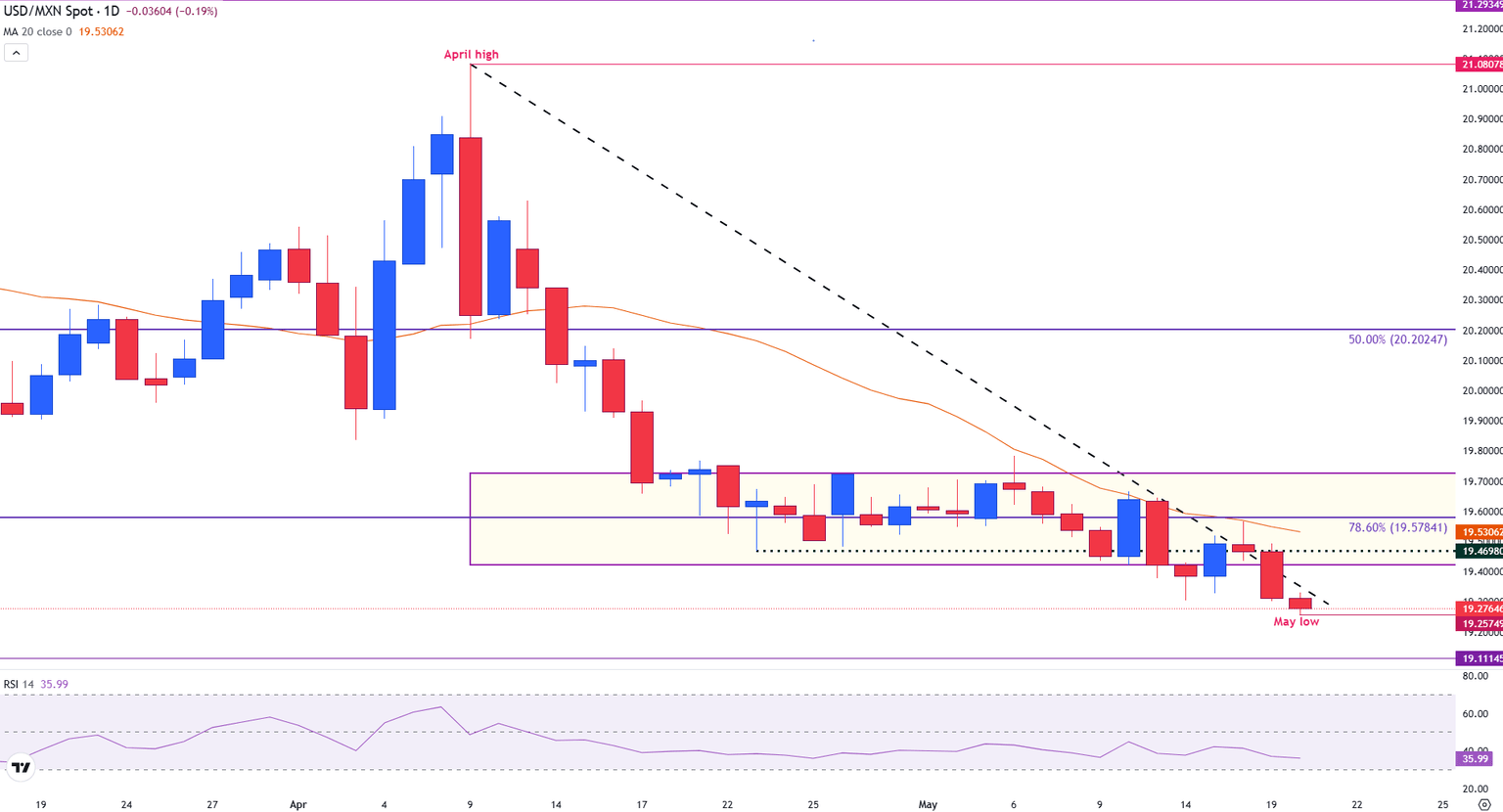Mexican Peso firms as the Greenback remains under pressure
- The Mexican Peso gains strength ahead of Trump's "Big Beautiful" tax legislation.
- The projected economic outlook for the United States and the direction of the US Dollar remain the key drivers for the USD/MXN exchange rate.
- USD/MXN remains below critical technical levels with bearish momentum forcing the RSI lower.

The Mexican Peso (MXN) is holding firm against the US Dollar (USD) on Tuesday after reaching a fresh year-to-date high in the early hours of the European session as markets turn cautious ahead of Wednesday’s House vote on President Trump’s “One Big Beautiful Bill.”
The legislative uncertainty surrounding the proposed tax package weighs on the USD, with investors assessing its potential implications for US fiscal policy and debt levels.
As the market responds, USD/MXN continues to trade below the pivotal level of 19.30 at the time of writing.
Mexican Peso daily digest: USD/MXN remains at the mercy of the Greenback
- As the US Dollar drives broader market direction, shifts in USD sentiment, driven by US fiscal policy, economic data, or Fed signals, tend to dictate the short-term trajectory of USD/MXN, with the Peso reacting accordingly.
- The House will vote on President Trump’s “One Big Beautiful Bill,” which aims to extend the 2017 Tax Cuts and Jobs Act and introduce new tax relief measures.
- While the bill could boost short-term growth, it is projected to increase the federal deficit significantly over the next decade, raising concerns about long-term US debt sustainability and putting pressure on the US Dollar.
- Throughout the day, Fed officials Thomas Barkin, Alberto Musalem, Adriana Kugler, Raphael Bostic, Mary Daly, and Beth Hammack are scheduled to speak, with markets closely watching their remarks for clues on the Fed’s policy outlook amid fiscal and economic uncertainty.
- On Friday, Moody’s became the latest credit agency to downgrade the US sovereign rating.
- As perceived credit risk rises, the US must offer higher interest rates to attract investors who might otherwise shift capital to alternative safe-haven assets.
- On Wednesday, Mexico will release its March retail sales data, while on Thursday, the country will release the first half-month inflation for May and the Gross Domestic Product (GDP) data for the first quarter.
- On the US side, S&P Global will release the preliminary Purchasing Managers Index (PMIs) for May and Existing Home Sales data for April on Thursday for fresh economic signals.
- In short, the USD/MXN pair is sensitive to data that reshapes expectations for growth, inflation, and central bank direction in either country.
Mexican Peso technical analysis: Peso steadies with USD/MXN below 19.30
The USD/MXN has dropped to its lowest level since October, breaking through the previous psychological support level, which has now turned into resistance at 19.30.
Currently, prices are below the descending trendline established during the decline in April.
The Relative Strength Index (RSI) indicator at 36 shows an increase in bearish momentum. Since the 30 mark is considered a potential oversold territory, the bearish trend remains intact, with the next key support level at the round number of 19.20.
USD/MXN daily chart

If prices fall below 19.20, it could open the door to the October low of around 19.11, paving the way towards the 19.00 mark.
On the other hand, if USD strength resurges and prices rise above the descending trendline, USD/XN could see a retest of the April low near 19.47, bringing the 20-day Simple Moving Average (SMA) into play at 19.53.
Risk sentiment FAQs
In the world of financial jargon the two widely used terms “risk-on” and “risk off'' refer to the level of risk that investors are willing to stomach during the period referenced. In a “risk-on” market, investors are optimistic about the future and more willing to buy risky assets. In a “risk-off” market investors start to ‘play it safe’ because they are worried about the future, and therefore buy less risky assets that are more certain of bringing a return, even if it is relatively modest.
Typically, during periods of “risk-on”, stock markets will rise, most commodities – except Gold – will also gain in value, since they benefit from a positive growth outlook. The currencies of nations that are heavy commodity exporters strengthen because of increased demand, and Cryptocurrencies rise. In a “risk-off” market, Bonds go up – especially major government Bonds – Gold shines, and safe-haven currencies such as the Japanese Yen, Swiss Franc and US Dollar all benefit.
The Australian Dollar (AUD), the Canadian Dollar (CAD), the New Zealand Dollar (NZD) and minor FX like the Ruble (RUB) and the South African Rand (ZAR), all tend to rise in markets that are “risk-on”. This is because the economies of these currencies are heavily reliant on commodity exports for growth, and commodities tend to rise in price during risk-on periods. This is because investors foresee greater demand for raw materials in the future due to heightened economic activity.
The major currencies that tend to rise during periods of “risk-off” are the US Dollar (USD), the Japanese Yen (JPY) and the Swiss Franc (CHF). The US Dollar, because it is the world’s reserve currency, and because in times of crisis investors buy US government debt, which is seen as safe because the largest economy in the world is unlikely to default. The Yen, from increased demand for Japanese government bonds, because a high proportion are held by domestic investors who are unlikely to dump them – even in a crisis. The Swiss Franc, because strict Swiss banking laws offer investors enhanced capital protection.
Author

Tammy Da Costa, CFTe®
FXStreet
Tammy is an economist and market analyst with a deep passion for financial markets, particularly commodities and geopolitics.

















